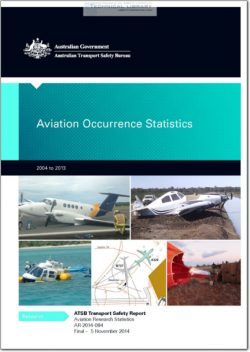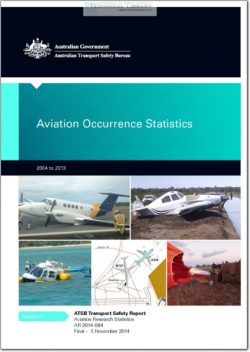ATSB-AR-2014-084

- Version
- 189 Downloads
- 13.64 MB File Size
- 1 File Count
- August 9, 2016 Create Date
- August 9, 2016 Last Updated
Aviation Occurrence Statistics - 2004 to 2013

Each year, the Australian Transport Safety Bureau (ATSB) receives accident and incident
notifications from pilots, airline operators, air traffic control, maintenance personnel, aerodrome
operators, emergency services authorities, and from the general public. The reporting of these
aviation accidents and incidents, collectively termed occurrences, assists the ATSB in monitoring
safety through its core functions of independent investigation and the analysis of data to identify
emerging trends.
The types of occurrences that are required to be reported to the ATSB are detailed in the
Transport Safety Investigation Regulations 2003. Depending on the seriousness of the event (in
terms of the potential to cause injury or damage) and the category of operation, these occurrences
are categorised as either immediately reportable matters (lRMs) or routine reportable matters (RRMs).
Aviation occurrence statistics are updated and published annually by the ATSB, and can be
subject to change pending the provision of new information to the ATSB. When using these
statistics, it is important to remember that occurrence data is provided to the ATSB by responsible
persons as defined in Part 2.5 of the Regulations. The ATSB accepts no liability for any loss or
damage suffered by any person or corporation resulting from the use of these statistics.
NOTE: In this edition of Aviation occurrence statistics, there are generally less incidents shown
than earlier editions due to a change of A TSB policy. Events involving operational non-compliance
with air traffic control verbal or published instruction, airspace infringement, and breakdown of co-
ordination between air navigation service providers, when they occur without any other occurrence
event, have not been included as incidents in this edition. See Appendix A — Explanatory notes for
more detail.
The overall number of safety occurrences alone does not represent a complete picture of aviation
safety. For meaningful comparisons to be made between different types of aircraft and the
operations they perform, aviation occurrence statistics are often presented as a rate per million
hours flown or per million departures.
The Bureau of Infrastructure, Transport and Regional Economics (BITRE) collect and compile this
activity data from reports submitted by airlines, and from other aircraft operators through the
General Aviation Activity Survey.
Activity data used to calculate rates in this report can be found in Table 1 and Table 2. This data is
rounded to the nearest thousand hours (or thousand departures) to present the size or magnitude
of the data in more general terms. Specific activity data for movements of non-Australian (foreign)
registered aircraft is limited, but is tabulated where available.
| File | Action |
|---|---|
| ATSB-AR-2014-084 Aviation Occurrence Statistics - 2004 to 2013.pdf | Download |

Comment On This Post